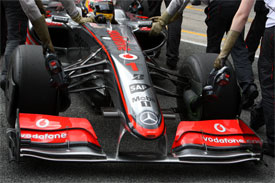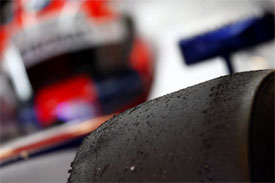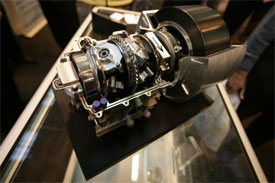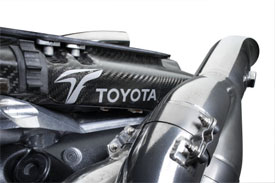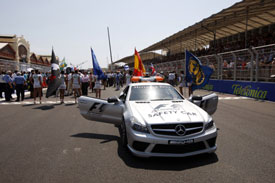New-look wings
Dramatically restyled wings are the most visable change for F1 2009. Front wings have grown wider and been lowered, while the rear wing changes in the opposite direction - becoming narrower and taller. Heavy restrictions on additional bodywork appendages mean the winglets and turning vanes that had sprouted all over the cars in recent years are no more.
Both changes are designed to increase overtaking by reducing the turbulent wake generated by a car in front. A futher helping hand is provided by the new adjustable front wings, which each driver can move within a six degree range twice per lap to assist with passing, or to improve the handling.
Slick tyres
After a decade of grooves, slick tyres make a welcome return as part of the measures to put mechanical grip before aerodynamic performance. The speed gain from the additional rubber should be negated by the smaller wings, but slicks ought to assist overtaking. Green stripes on the sidewalls will differentiate between the two Bridgestone compounds used at each race.
KERS
F1's biggest green technology gesture yet, the kinetic energy recovery systems turn energy generated under braking into an 80bhp power boost for 6.6 seconds per lap. The devices have proved tricky to master, and few teams will start the season with them. Some believe KERS boost F1's environmental credentials and help road car developments, others are concerned about the systems' safety and the high costs involved.
Testing ban
No testing is now permitted between the start of the season and 31 December, in one of the most significant of the swathes of cost cuts. Limited post-season young driver runs are the only exception to the ban. Total testing is limited to 15,000km per team, and there are also new restrictions on the size and speed of windtunnels.
Engines
Each car now has an allocation of eight engines for the whole season as the two-race engine rule is binned in favour of a more flexible but ultimately cheaper scheme. Teams can rotate those engines as they wish (although changes between practice and qualifying are banned), but grid penalties will be applied once the eight-engine limit is exceeded. Bar the FIA-approved adjustments to the Renault V8, the engine freeze remains in place and the rev limit has come down to 18,000rpm.
Safety car rules
Safety car timing will no longer be so decisive in race results with the end of the pit closure rules. Teams can now pit at any time during a safety car period, but drivers must return to the pits at a specified reduced pace - which will be monitored by GPS and new software - to avoid a penalty.
Published fuel loads
While the qualifying format will remain the same, there will be no more mystery about how light or heavy drivers were running to achieve their top 10 grid spots. This year the weights of all the cars will be made public after qualifying to make the races easier to understand.
New season finale
After three years of Interlagos title-deciders, the finale moves to Abu Dhabi's new Marina Bay circuit. Its creators promise to set a new standard for F1 venues with this waterside track, which features quirks like a hotel over the top of the circuit and run-off areas under grandstands to let fans get closer to the action.
New entrants
Recent seasons have seen a glut of ultra-talented newcomers, but with teams prizing experience under the testing ban, Toro Rosso's latest Red Bull protege Sebastien Buemi is the only GP2 graduate for 2009. There's a new name on the grid in the form of Brawn GP after Ross Brawn's takeover of the Honda team, which could mark the start of a shift away from giant manufacturer squads towards leaner, engineer-led teams.
Meeting the fans
This year all drivers will have to make themselves available to sign autographs during grand prix Fridays, and all drivers plus a spokesperson from each team are compelled to meet the press after qualifying and the race, or during the events if they are eliminated or retire, making it easier for journalists and TV crews to relay information from the track.
